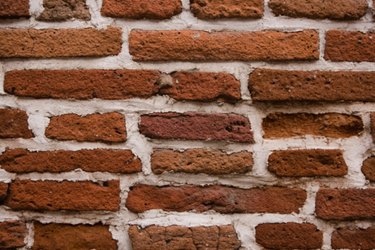Things You'll Need
Basic measuring and marking tools
Lead anchors
Masonry bit
Hammer drill
Bristle pipe cleaning brush
Hammer
Screw fastener

Lead anchors, which are sleeves featuring machined threading centered inside, are commonly used with screw fasteners to secure objects into place. Lead anchors can be made of plastic or metal material and are designed to be used with drywall or masonry walls, floors or ceilings. Use metal lead anchors when drilling into masonry materials such as brick. To insert screws into brick walls, create holes with a hammer drill equipped with a masonry bit. After lead anchors are inserted into the holes, screw fasteners will slide into their centers and cause the anchors to expand.
Step 1
Make marks on the brick wall to indicate where the lead anchors will be installed.
Video of the Day
Step 2
Refer to the lead anchor packaging to determine what masonry bit diameter size to use. Insert the appropriate-sized masonry bit into the hammer drill and inspect the tool for any defects.
Step 3
Place the tip of the masonry bit against the wall and slowly start the hammer drill. Drill straight into the wall; allow the bit to penetrate slightly before bringing the hammer drill to full speed.
Step 4
Clean the drilled holes out using a bristle pipe brush that is the same diameter as the hole.
Step 5
Slip the tapered end of the lead anchor into the hole. Tap the back base of the lead anchor with a hammer until it sits flush with the brick wall face.
Step 6
Align the hole of the object that is being secured to the brick wall to the hole at the center of the lead anchor. Insert a screw through the object and into the lead anchor. Tighten the screw with the correct tool.
Warning
Wear protective gear such as safety glasses, hearing protection and a dust mask to prevent injury when using power tools.
Video of the Day